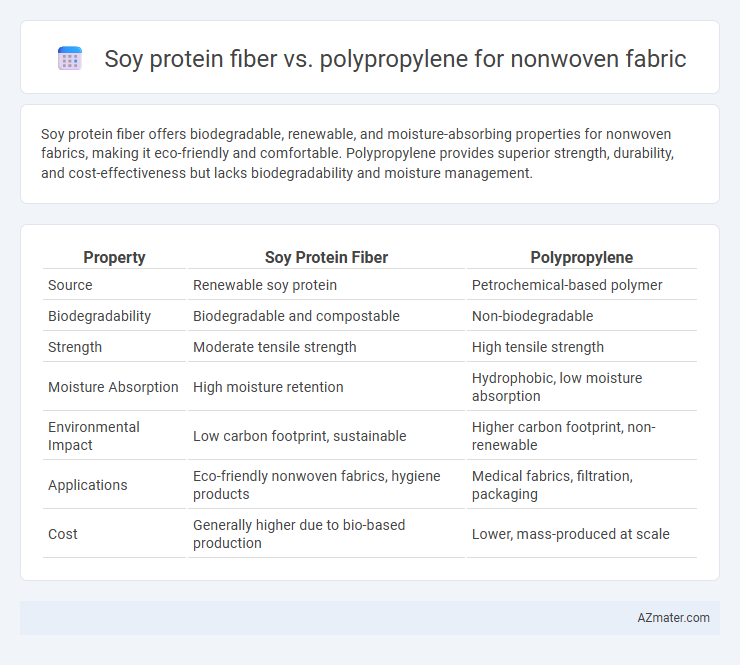Soy protein fiber offers biodegradable, renewable, and moisture-absorbing properties for nonwoven fabrics, making it eco-friendly and comfortable. Polypropylene provides superior strength, durability, and cost-effectiveness but lacks biodegradability and moisture management.
Table of Comparison
| Property | Soy Protein Fiber | Polypropylene |
|---|---|---|
| Source | Renewable soy protein | Petrochemical-based polymer |
| Biodegradability | Biodegradable and compostable | Non-biodegradable |
| Strength | Moderate tensile strength | High tensile strength |
| Moisture Absorption | High moisture retention | Hydrophobic, low moisture absorption |
| Environmental Impact | Low carbon footprint, sustainable | Higher carbon footprint, non-renewable |
| Applications | Eco-friendly nonwoven fabrics, hygiene products | Medical fabrics, filtration, packaging |
| Cost | Generally higher due to bio-based production | Lower, mass-produced at scale |
Introduction to Nonwoven Fabrics
Nonwoven fabrics are engineered materials made from fibers bonded together by chemical, mechanical, heat, or solvent treatment, widely used in hygiene, filtration, and medical applications. Soy protein fiber, a biodegradable and renewable resource, offers eco-friendly advantages such as biodegradability and natural moisture management compared to synthetic polypropylene fibers known for their durability, chemical resistance, and cost-effectiveness. The choice between soy protein fiber and polypropylene significantly impacts the environmental footprint, performance, and application suitability of nonwoven fabrics in various industries.
Overview of Soy Protein Fiber
Soy protein fiber, derived from soybeans, is a biodegradable and renewable material increasingly used in nonwoven fabric production due to its excellent moisture absorption and antimicrobial properties. Unlike polypropylene, a synthetic polymer known for durability and chemical resistance, soy protein fiber offers enhanced environmental benefits and comfort in applications like medical textiles and hygiene products. Its ability to blend with other fibers improves fabric softness and breathability, making it a sustainable alternative in the nonwoven industry.
Polypropylene: The Industry Standard
Polypropylene is the industry standard for nonwoven fabric due to its excellent durability, moisture resistance, and cost-effectiveness, making it ideal for applications in hygiene products, medical textiles, and filtration. Its hydrophobic properties and chemical stability ensure superior performance compared to soy protein fiber, which, while biodegradable and eco-friendly, lacks the same level of strength and longevity. Polypropylene's versatility and widely established manufacturing processes solidify its dominance in the nonwoven fabric market.
Fiber Production Processes
Soy protein fiber production involves extracting soy protein from defatted soybeans, followed by wet spinning or electrospinning to form fibers with biodegradable properties, emphasizing sustainable agriculture feedstock. Polypropylene fiber is produced through polymerization of propylene monomers and melt spinning techniques, resulting in a synthetic, non-biodegradable fiber with high tensile strength and chemical resistance. The production of soy protein fiber demands more complex biochemical processing steps compared to the thermoplastic extrusion process used for polypropylene fibers in nonwoven fabric manufacturing.
Mechanical Properties Comparison
Soy protein fiber exhibits superior tensile strength and flexibility compared to polypropylene in nonwoven fabrics, making it more resistant to tearing under stress. The natural fibrous structure of soy protein enhances elongation at break, providing better durability in dynamic applications. Polypropylene, while lightweight and chemically resistant, often lacks the elasticity and impact resistance found in soy protein-based nonwoven materials.
Environmental Impact and Sustainability
Soy protein fiber offers superior environmental benefits over polypropylene in nonwoven fabric production due to its biodegradability and renewable plant-based origin, significantly reducing landfill waste and microplastic pollution. Polypropylene, a petroleum-derived synthetic polymer, is resistant to natural degradation, contributing to long-term environmental persistence and increased carbon footprint during production and disposal. The sustainable profile of soy protein fiber incorporates lower energy consumption and greenhouse gas emissions, enhancing eco-friendly textile manufacturing and supporting circular economy principles.
Biodegradability and End-of-Life Considerations
Soy protein fiber offers superior biodegradability compared to polypropylene, breaking down naturally within months in composting environments, significantly reducing environmental impact. Polypropylene, a petroleum-based polymer, persists in landfills for centuries due to its resistance to microbial degradation, posing considerable challenges in waste management. End-of-life options for soy protein nonwoven fabrics include composting and anaerobic digestion, whereas polypropylene primarily relies on recycling or incineration, highlighting the sustainable advantage of soy protein fibers in circular economy applications.
Cost Analysis and Commercial Viability
Soy protein fiber exhibits higher raw material costs compared to polypropylene due to limited large-scale production and agricultural dependency, impacting overall manufacturing expenses for nonwoven fabrics. Polypropylene offers cost-efficient mass production with stable pricing, making it more commercially viable for applications requiring budget-friendly and consistent supply. Despite soy protein's biodegradability advantage, polypropylene dominates the market driven by its superior cost-benefit ratio and widespread industrial adoption.
Applications in Nonwoven Fabrics
Soy protein fiber offers biodegradability and enhanced moisture absorption, making it ideal for hygiene products, agricultural mulch films, and medical dressings in nonwoven fabric applications. Polypropylene, known for its durability, chemical resistance, and low cost, is commonly used in disposable garments, filtration media, and geotextiles. Both fibers cater to distinct industrial needs, with soy protein fiber favored in eco-friendly, sustainable products, while polypropylene dominates high-performance, cost-sensitive applications.
Future Prospects and Innovations
Soy protein fiber offers sustainable advantages over polypropylene for nonwoven fabrics due to its biodegradability and renewable source, aligning with increasing environmental regulations and consumer demand for eco-friendly materials. Innovations in modifying soy protein fiber's durability and moisture resistance are expanding its applicability in hygiene products, agricultural covers, and filtration media. Future prospects include blending soy protein fiber with other bio-based polymers to enhance performance while maintaining sustainability, potentially replacing polypropylene in various industrial and medical nonwoven applications.

Infographic: Soy protein fiber vs Polypropylene for Nonwoven fabric
 azmater.com
azmater.com